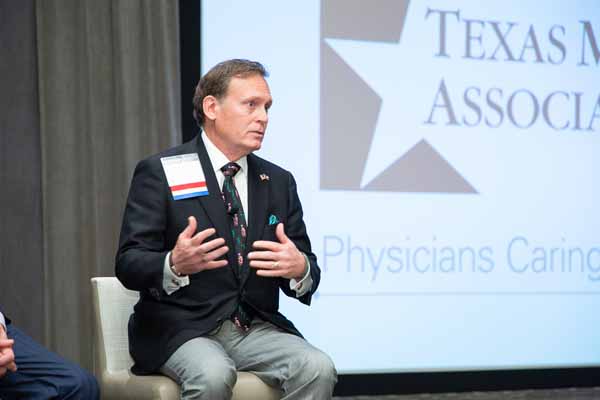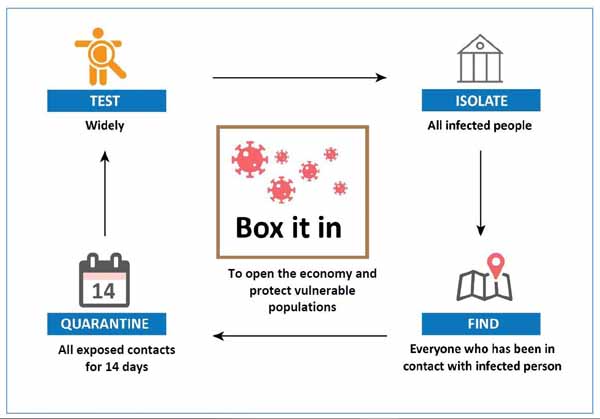
When Gov. Greg Abbott announced Monday that he will relax some limitations on public gatherings and non-urgent elective surgeries beginning May 1, he also unveiled a plan to reopen Texas businesses and social activities.
The plan, which was developed with input from state medical experts and government and business leaders, calls for a phased approach that emphasizes testing and contact tracing – or identifying everyone who’s come into contact with someone who contracted COVID-19.
It also calls on Texans to continue to take health precautions, such as avoiding face-to-face contact, wearing masks or other protection, washing hands, and disinfecting surfaces.
The goal is to return Texas to some kind of financial normalcy while minimizing the risk of more COVID-19 infections.
“We’ll wait and see what happens over the next two weeks, see if there’s any increased activity out there with regard to the disease, which we fully expect there’ll be more people that get the disease,” John Zerwas, MD, executive vice chancellor for health affairs at The University of Texas System and one of four physicians on the governor’s strike force, told Texas Medicine Today on Tuesday. “What you obviously want to remember is that this whole effort is to try to prevent health care systems from being overrun by high numbers of COVID patients.”
Texas so far has been able to test 15,000 to 20,000 people a day, but health authorities plan to expand that to about 30,000 per day soon with quick turnaround, the governor’s report says.
“We think we can do probably 26,000-30,000 tests a day if you had the samples and if you had the reagents to run the test and so forth. I think we have that capability,” said Dr. Zerwas (pictured above). “We’ve done as many as 20,000 tests in a 24-hour period. But we’re going to pretty much really try to increase that.”
Governor Abbott’s plan calls for more testing sites and increased testing capacity by:
- Using Texas Military Department teams to establish 25 mobile testing sites by May 1, many in rural parts of the state, where testing options are limited, the report says. Also, the Federal Emergency Management Agency (FEMA) has funded drive-thru sites in several counties. Texas currently has about 300 testing sites, according to the Texas Department of State Health Services (DSHS) map of test collection locations.
- Identifying and maximizing current laboratory capacity. For instance, the DSHS Public Health Laboratory began using a new COVID-19 test from PerkinElmer that allows it to process 800 tests per day, up from 150, the report says.
- Producing, procuring, and distributing testing supplies needed to collect and transport specimens to a testing laboratory.
- Expanding laboratory capacity, including at the DSHS laboratory and through new testing platforms, such as Abbott Labs ID NOW. Texas A&M Veterinary Medical Diagnostic Lab also has gained certification to begin running COVID-19 testing, the report says.
- Continuing to develop a strategy that increases awareness, boosts lab capacity, enables virtual care, and targets high-risk populations, such as the elderly.
The governor’s plan contains three phases of contact tracing – drilling in on a high-level strategy of “boxing in” the disease using widespread testing, isolating all infected people, and finding and quarantining everyone they’ve come in contact with for a 14-day period.

Phase II of the plan, which was scheduled to start yesterday, includes adding 1,000 contact tracers to the more than 1,100 that were recruited, trained, and mobilized in Phase I.
Several hundred of those additional tracers are DSHS employees “from program areas that are not business critical and do not have proper equipment … or have job duties that are not suited to telework,” a DSHS official told Texas Medicine Today.
The second phase also includes launching a COVID-19 contact tracing call center and Texas Health Trace, a statewide app that includes a self-checker and a mechanism to report if you’ve been exposed.
In phase III, scheduled to start by May 11, the governor’s plan calls for a fully mobilized contact tracing workforce of up to 4,000 people.
“It’s where we anticipated being right now, and there hasn’t been a huge demand on them right now. What we have available now is commensurate with where we are in terms of just loosening up the economy,” Dr. Zerwas said. “That actually doesn’t happen until May 1, and it’s going to happen slowly. A lot of people are going to still be pretty concerned about getting out and engaging in too much of a congregate setting. There’s some businesses that, even though they’ll have the opportunity to open up, they won’t open up, and that’s their prerogative.”
Testing and contact tracing are time-consuming activities that require a lot of staff, so Texans should demand transparency in testing results, says former Texas Health Commissioner Eduardo Sanchez, MD.
“What we’ve witnessed at the federal level is talk about what’s going to happen and not always the timely delivery,” he said. “All Texans need to monitor and stay abreast of the progress made in terms of testing, containment, and isolation.”
People need to know not just the number of positive tests but the number of positive tests that lead to other people with positive tests, says Dr. Sanchez, who is now chief medical officer for prevention and chief of the Center for Health Metrics and Evaluation for the American Heart Association in Dallas.
“That’s the sign that the contact tracing is doing what we’ve put it in place to do,” he said.